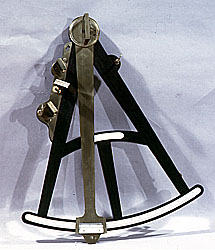 90. Octant by P. Dollond
90. Octant by P. Dollond
The octant - an indispensable instrument for working out the shipís position on the sea - takes its name from the fact that its sector is the eighth part of a circle, i.e. fourty-five degrees.
The reflecting octant was introduced by John Hadley (1682-1744) in 1731 (op. cit.) even if the credit has to be shared, according to some commentators, with the American settler, glazier and plumber from Philadelphia, Thomas Godfrey (1704-1749). Thanks to the use of mirrors, it represented a real advance on the cross-staff and back-staff (or Davis staff). The breakthrough was in using two successive mirrors to reflect the Sunís image before it reached the observerís eye. In this way the observer could see simultaneously in the fixed mirror the horizon and the image of the Sun reflected twice.
It was thus possible to keep on the horizon, notwithstanding the movement of the ship, a star that had been brought there by reflection, thereby eliminating the causes of measurement imprecision at sea with instruments like the nautical astrolabe or quadrant.
Towards the end of the XVIIIth century the octant was replaced by the more accurate - and also more expensive - sextant [file 91], though because of its relative cheapness it remained in use until the beginning of this century.
In the first half of the XIXth century brass octants replaced ebony ones and, after 1850, metal instruments monopolized the market. While boxwood scales were sometimes used on the cheaper models, generally speaking graduated scales were engraved on ivory and brass.
In the peripheral circular segment of Dollondís octant, the graduation in ninety parts, each subdivided in three, is in ivory with a vernier, also in ivory, located at the end of the scale, which serves to further subdivide the graduation in twenty parts. The large mirror is screwed onto the other end; two smaller mirrors, at right angles, are fastened to the side of one of the cross-struts of the frame, near the three different tinted glass shades. Two perforated metal pinnules are used as sights.
The signature is Dollond, London. The instrument is kept in a wooden case, shaped, probably original.
J.A. Bennett (1987).
F. Farinelli (1979), p. 190.
J. Hadley (1731), p. 145.
G. L'E. Turner (1991), p. 240.